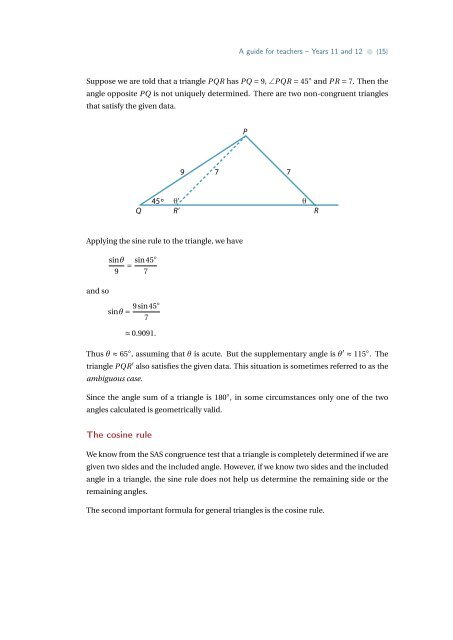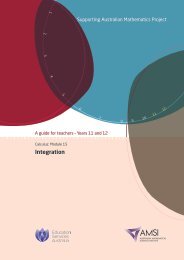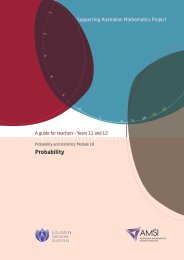Trigonometric functions and circular measure - the Australian ...
Trigonometric functions and circular measure - the Australian ...
Trigonometric functions and circular measure - the Australian ...
- No tags were found...
You also want an ePaper? Increase the reach of your titles
YUMPU automatically turns print PDFs into web optimized ePapers that Google loves.
A guide for teachers – Years 11 <strong>and</strong> 12 • {15}Suppose we are told that a triangle PQR has PQ = 9, ∠PQR = 45 ◦ <strong>and</strong> PR = 7. Then <strong>the</strong>angle opposite PQ is not uniquely determined. There are two non-congruent trianglesthat satisfy <strong>the</strong> given data.P97745 º θ'θQ R’ RApplying <strong>the</strong> sine rule to <strong>the</strong> triangle, we have<strong>and</strong> sosinθ9= sin45◦7sinθ = 9sin45◦7≈ 0.9091.Thus θ ≈ 65 ◦ , assuming that θ is acute. But <strong>the</strong> supplementary angle is θ ′ ≈ 115 ◦ . Thetriangle PQR ′ also satisfies <strong>the</strong> given data. This situation is sometimes referred to as <strong>the</strong>ambiguous case.Since <strong>the</strong> angle sum of a triangle is 180 ◦ , in some circumstances only one of <strong>the</strong> twoangles calculated is geometrically valid.The cosine ruleWe know from <strong>the</strong> SAS congruence test that a triangle is completely determined if we aregiven two sides <strong>and</strong> <strong>the</strong> included angle. However, if we know two sides <strong>and</strong> <strong>the</strong> includedangle in a triangle, <strong>the</strong> sine rule does not help us determine <strong>the</strong> remaining side or <strong>the</strong>remaining angles.The second important formula for general triangles is <strong>the</strong> cosine rule.
















